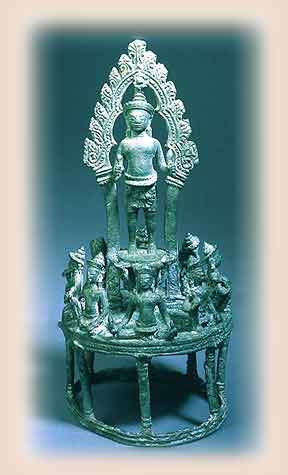 |
 |
 |
 |
 |
 |
 |
 |
 |
 |
| concept of temples | legends of gods | profile of temple | gallery of images | types of pujas | events & activities | donations & prasad | prayers & invocations | hiring of auditorium | comments & copyright |
 |
 |
 |
 |
 |
 |
 |
 |
 |
 |
| concept of temples | legends of gods | profile of temple | gallery of images | types of pujas | events & activities | donations & prasad | prayers & invocations | hiring of auditorium | comments & copyright |
Shastras
Mandalas
Garbhgriha
God & His entourage
Shikara
Rites of conservation
The design & construction of Hindu temples are theoretically determined by the text called Shastras. Shilpashastras deal with sculpture and those of Vastushastras are concerned with architecture. TopAccording to VastuShastras, the temple is a representation of the cosmos, symbolically and in miniature. Thus, just as cosmic diagrams or the mandalas (as shown in the diagram) were painted as 2-D representations of the cosmos with the deity and the palace at the center, so the temple was regarded as a 3-D mandala, illustrating the same universe. In both the mandala and the temple the deity occupies the centre. This central sanctuary chamber is the Garbhgriha, literally the 'womb-chamber'. Like a king surrounded by his court, the deity in the temple is surrounded by his entourage. These are arranged in increasing order of precedence as one moves towards the idol: his consort nearest, then his mount (usually a real or mythological animal), the other, usually subsidiary, deities in his group, the deities who stand guard over the eight direction (ashtdikpalas), the Gods of the planets (navagrahas), the saints who have lovingly laboured in the service of the God, the various local folk deities and lastly and thus farthest from the sanctury the sacred plants associated with the cult (as shown in the diagram). In Hindu cosmology, the centre of the universe is conceived of as a mountain, Meru. From the base of the Mount Meru, the continents spread out in all directions, with India to the south. Meru is considered to be the home of Gods, ruled over by Indra. Thus, the sanctuary of an Indian Temple invariably has a tower superstructure placed above the sanctuary; the Sanskrit terms for this tower-element is 'shikara'. The God in the innermost part of the temple is thus placed within a cave like or womb like chamber. Rites of conservation carried out by Brahmins are listed in the shastras. They include the placing of a foundation deposit prior to commencement of building, right thru to rites for the placement of the final anchoring stone elements which crown the shikara - these are the ribbed and fruit-like 'amalakas', above which is the pot shaped 'Kalasha'. The emphasis on water is important and if a river is not available, a tank should be provided. These, traditionally, are all necessary elements in the correct constructions of a temple. |
 Mandala |
 Deity surrounded by his entourage |
Your opinions & queries regarding
Mahalakshmi Temple or website should be directed to temple@rpg.in
Copyright © 2005 [RPG Enterprises
Limited]. All rights reserved.
Last modified: Friday November 10, 2006